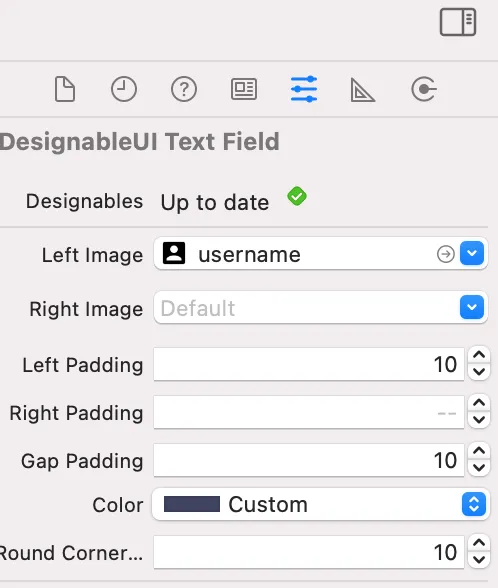以上所有答案都很好,但是在这里我通过@IBDesignable添加代码。

@IBDesignable class DesignableUITextField: UITextField {
override func leftViewRect(forBounds bounds: CGRect) -> CGRect {
var textRect = super.leftViewRect(forBounds: bounds)
textRect.origin.x += leftPadding
return textRect
}
override func rightViewRect(forBounds bounds: CGRect) -> CGRect {
var textRect = super.rightViewRect(forBounds: bounds)
textRect.origin.x -= rightPadding
return textRect
}
@IBInspectable var leftImage: UIImage? {
didSet {
updateView()
}
}
@IBInspectable var rightImage: UIImage? {
didSet {
updateRightView()
}
}
@IBInspectable var leftPadding: CGFloat = 0
@IBInspectable var rightPadding: CGFloat = 0
@IBInspectable var gapPadding: CGFloat = 0
@IBInspectable var color: UIColor = UIColor.lightGray {
didSet {
updateView()
}
}
@IBInspectable var cornerRadius: CGFloat = 0
@IBInspectable var borderColor: UIColor? = .lightGray
override func draw(_ rect: CGRect) {
layer.cornerRadius = cornerRadius
layer.masksToBounds = true
layer.borderWidth = 1
layer.borderColor = borderColor?.cgColor
}
func roundCornersRadiusTextField(radius:CGFloat) {
roundCorners(corners: [UIRectCorner.topLeft, UIRectCorner.topRight, UIRectCorner.bottomLeft, UIRectCorner.bottomRight], radius:radius)
}
func roundBottomCornersRadius(radius:CGFloat) {
roundCorners(corners: [UIRectCorner.topLeft, UIRectCorner.topRight], radius:radius)
}
func updateView() {
if let image = leftImage {
leftViewMode = UITextField.ViewMode.always
let imageView = UIImageView(frame: CGRect(x: 0, y: 0, width: 20, height: 20))
imageView.contentMode = .scaleAspectFit
imageView.image = image
imageView.tintColor = color
leftView = imageView
} else {
leftViewMode = UITextField.ViewMode.never
leftView = nil
}
attributedPlaceholder = NSAttributedString(string: placeholder != nil ? placeholder! : "", attributes:[NSAttributedString.Key.foregroundColor: color])
}
func updateRightView() {
if let image = rightImage {
rightViewMode = UITextField.ViewMode.always
let imageView = UIImageView(frame: CGRect(x: 0, y: 0, width: 20, height: 20))
imageView.contentMode = .scaleAspectFit
imageView.image = image
imageView.tintColor = color
rightView = imageView
} else {
rightViewMode = UITextField.ViewMode.never
rightView = nil
}
attributedPlaceholder = NSAttributedString(string: placeholder != nil ? placeholder! : "", attributes:[NSAttributedString.Key.foregroundColor: color])
}
func roundCorners(corners:UIRectCorner, radius:CGFloat) {
let bounds = self.bounds
let maskPath = UIBezierPath(roundedRect: bounds, byRoundingCorners: corners, cornerRadii: CGSize(width: radius, height: radius))
let maskLayer = CAShapeLayer()
maskLayer.frame = bounds
maskLayer.path = maskPath.cgPath
self.layer.mask = maskLayer
let frameLayer = CAShapeLayer()
frameLayer.frame = bounds
frameLayer.path = maskPath.cgPath
frameLayer.strokeColor = UIColor.darkGray.cgColor
frameLayer.fillColor = UIColor.init(red: 247, green: 247, blue: 247, alpha: 0).cgColor
self.layer.addSublayer(frameLayer)
}
private var textPadding: UIEdgeInsets {
let p: CGFloat = leftPadding + gapPadding + (leftView?.frame.width ?? 0)
return UIEdgeInsets(top: 0, left: p, bottom: 0, right: 5)
}
override open func textRect(forBounds bounds: CGRect) -> CGRect {
return bounds.inset(by: textPadding)
}
override open func placeholderRect(forBounds bounds: CGRect) -> CGRect {
return bounds.inset(by: textPadding)
}
override open func editingRect(forBounds bounds: CGRect) -> CGRect {
return bounds.inset(by: textPadding)
}}




borderWidth == 0或borderColor == .clear时会出现这种情况。通常情况下,我会避免直接自定义UITextField。我会将其设置为透明,并嵌入到一个处理背景UI自定义的视图中。 - undefined